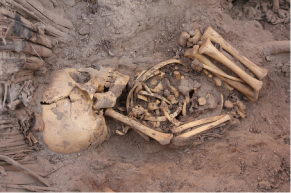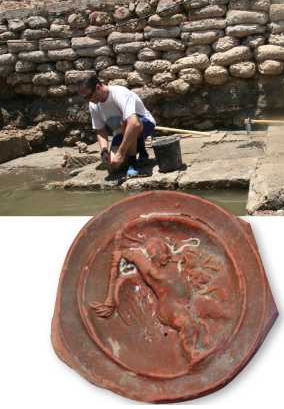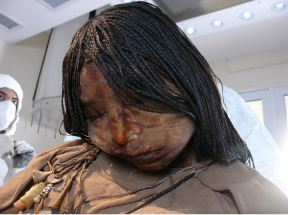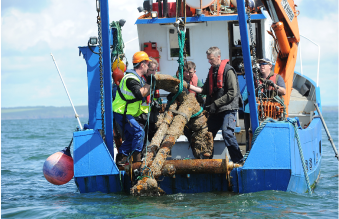From The Trenches
Peru’s Mysterious Infant Burials
By NIKHIL SWAMINATHAN
Friday, October 05, 2012
 The ancient Peruvian site of Pachacamac is known to have been an important pilgrimage destination for sick travelers seeking cures during the Inca period of the fifteenth and sixteenth centuries. But the site had been occupied since as early as A.D. 200. Between roughly A.D. 900 and the beginning of the Inca period, the Ychsma culture inhabited Pachacamac. Archaeologists know primarily about Ychsma rulers, who built pyramidal palaces filled with simple, secular items related to weaving and animal husbandry. When a local lord died, the members of his household would be entombed in his palace, and his successor would build a new pyramid nearby.
The ancient Peruvian site of Pachacamac is known to have been an important pilgrimage destination for sick travelers seeking cures during the Inca period of the fifteenth and sixteenth centuries. But the site had been occupied since as early as A.D. 200. Between roughly A.D. 900 and the beginning of the Inca period, the Ychsma culture inhabited Pachacamac. Archaeologists know primarily about Ychsma rulers, who built pyramidal palaces filled with simple, secular items related to weaving and animal husbandry. When a local lord died, the members of his household would be entombed in his palace, and his successor would build a new pyramid nearby.
This spring archaeologists discovered a massive tomb at Pachacamac. The oval-shaped structure contains the remains of 36 adults and 43 children, all buried in the fetal position. Around the perimeter of the tomb’s reed roof were the remains of a dozen infants with their heads pointed toward the center of the 63-foot-long burial chamber below. Researchers estimate the tomb dates to about a.d. 1000 based on the style of pottery accompanying the burials. Other grave goods include gold and copper bracelets, wooden masks, and canine remains.
Peter Eeckhout, an archaeologist at the Université libre de Bruxelles in Belgium, hopes the new find will illuminate the “social organization of the common people, which is, in our opinion, reflected in their burial practices.” To that end, he is attempting to discern if the infants atop the tomb were sacrificed or if they died of natural causes. Further, dating of the burials found in the chamber will determine whether the structure was a collective tomb reopened over successive generations for new burials or if all the bodies were entombed at the same time.
Pharaoh’s Port?
By MATI MILSTEIN
Friday, October 05, 2012
 A 2,300-year-old harbor has been uncovered off the coast of the Israeli city of Acre. An Israel Antiquities Authority (IAA) and University of Rhode the only one in a protected natural bay.
A 2,300-year-old harbor has been uncovered off the coast of the Israeli city of Acre. An Israel Antiquities Authority (IAA) and University of Rhode the only one in a protected natural bay.
“Recently, a find was uncovered that suggests we are excavating part of [Acre’s] military port,” says Kobi Sharvit, director of the IAA’s Marine Archaeology Unit. “We know the pharaoh Ptolemy Philadelphus built a harbor for his fleet at this time. Usually military ships were kept out of the water in ‘shipshades’ like what we found here.” The size and design of the structure suits warships from that period. Large mooring stones, pottery vessels, and metallic objects, many of military function, were also found. Initial examination reveals the items originated across the eastern Mediterranean, including at Aegean Sea islands such as Knidos, Rhodes, and Kos. Sharvit’s team will next attempt to determine when the harbor was destroyed.
High Rise of the Dead
By ROGER ATWOOD
Friday, October 05, 2012
 Like builders everywhere, the ancient Zapotec made the most of valuable real estate by building up, rather than out. At Atzompa, near the southern city of Oaxaca, Mexican archaeologists discovered three burial chambers stacked one on top of the other. Dating from a.d. 650 to 850, the unusual vertical design allowed builders to take advantage of the tombs’ breezy hilltop location, with the lowest tomb built into the ground and two later chambers erected above it. The upper tombs were stripped of human remains, probably in antiquity, but whoever had ventured into the complex seems to have missed the basement tomb—it was sealed off with boulders and mud bricks, says archaeologist Eduardo García of Mexico’s National Institute of Anthropology and History. In the lowest tomb, archaeologists found a skeleton, apparently that of a male, and funerary offerings including a ceramic head painted in a vivid red pigment. Ceramic offerings showed little variation across levels, suggesting to García they may have held three successive generations of rulers. But the tomb’s most dazzling feature is a mural with designs representing a jaguar paw print and an I-shaped ball court—another sign that Atzompa, with at least three ball courts, was an important center for the sport, in which men bounced hard rubber balls off their hips. The mural “is exceptionally well preserved,” says García.
Like builders everywhere, the ancient Zapotec made the most of valuable real estate by building up, rather than out. At Atzompa, near the southern city of Oaxaca, Mexican archaeologists discovered three burial chambers stacked one on top of the other. Dating from a.d. 650 to 850, the unusual vertical design allowed builders to take advantage of the tombs’ breezy hilltop location, with the lowest tomb built into the ground and two later chambers erected above it. The upper tombs were stripped of human remains, probably in antiquity, but whoever had ventured into the complex seems to have missed the basement tomb—it was sealed off with boulders and mud bricks, says archaeologist Eduardo García of Mexico’s National Institute of Anthropology and History. In the lowest tomb, archaeologists found a skeleton, apparently that of a male, and funerary offerings including a ceramic head painted in a vivid red pigment. Ceramic offerings showed little variation across levels, suggesting to García they may have held three successive generations of rulers. But the tomb’s most dazzling feature is a mural with designs representing a jaguar paw print and an I-shaped ball court—another sign that Atzompa, with at least three ball courts, was an important center for the sport, in which men bounced hard rubber balls off their hips. The mural “is exceptionally well preserved,” says García.
Diagnosis of Ancient Illness
By SAMIR S. PATEL
Friday, October 05, 2012
 The Black Death, brucellosis, leprosy: The pathogens that cause these diseases have been identified in ancient remains by their DNA. But the presence of such DNA doesn’t necessarily mean that the person who carried it was sick. For example, one can carry the bacterium that causes tuberculosis for years without suffering from a serious cough, fever, and weight loss.
The Black Death, brucellosis, leprosy: The pathogens that cause these diseases have been identified in ancient remains by their DNA. But the presence of such DNA doesn’t necessarily mean that the person who carried it was sick. For example, one can carry the bacterium that causes tuberculosis for years without suffering from a serious cough, fever, and weight loss.
In the case of three well-preserved 500-year-old mummies found in 1999 on high-and-dry Llullaillaco peak in Argentina, forensic examination and DNA tests suggested that one of them—a 15-year-old girl known as the “Llullaillaco Maiden”—suffered from a lung infection. But the DNA was degraded and the finding wasn’t definitive. Recently, forensic pathologist Angelique Corthals of Stonybrook University noticed what looked like traces of blood and mucus around the maiden’s mouth. She and her colleagues used swabs to take samples, hoping to determine where in the body the blood had come from. The team employed a technique called shotgun proteomics, used in modern medicine to look for biomarkers of diseases such as cancer, which involves separating and identifying specific proteins. “Lo and behold, we actually found a lot,” she says. “We didn’t expect so many proteins would survive 500 years. We saw a whole profile of the body’s immune system.”
Samples from the maiden showed the presence of several proteins strongly associated with severe, chronic lung inflammation. Alongside the DNA and other tests, the protein profile clearly showed the maiden suffered from a lung infection at the time of death, caused by the genus of bacterium that causes tuberculosis.
Proteomics has several advantages over DNA testing in identifying ancient diseases. Proteins degrade more slowly than DNA. The technique is also cheaper and less susceptible to contamination by modern sources. And because proteomics shows immune response to active disease, it can in some cases be used to infer cause of death. But not for the maiden—she was a sacrifice.
Running Guns to Irish Rebels
By NIKHIL SWAMINATHAN
Friday, October 05, 2012
 After 14 months of planning, a crew has recovered two iron anchors from the wreck of a German ship that, in 1916, attempted to deliver arms to Irish Republicans. The Aud carried one million rounds of ammunition and 20,000 arms for use in the Republicans’ Easter Rising to free Ireland from British rule. When the Aud mistakenly landed more than 60 miles south of its intended destination, the British navy seized the ship. After being caught, the German captain chose to scuttle the boat off the coast of County Cork.
After 14 months of planning, a crew has recovered two iron anchors from the wreck of a German ship that, in 1916, attempted to deliver arms to Irish Republicans. The Aud carried one million rounds of ammunition and 20,000 arms for use in the Republicans’ Easter Rising to free Ireland from British rule. When the Aud mistakenly landed more than 60 miles south of its intended destination, the British navy seized the ship. After being caught, the German captain chose to scuttle the boat off the coast of County Cork.
“Very little of the Aud actually survives, as it was depth-charged and used for target practice a number of times in the past,” says archaeologist Laurence Dunne, who helped lead the recovery effort. All that remains intact besides the anchors—one of which weighs half a ton, while the other is just less than two tons—is a section of the bow and a boiler. Dunne estimates it will take three to four years to complete conservation work on the anchors.
Advertisement
Advertisement
IN THIS ISSUE
From The Trenches
The Desert and the Dead
Fractals and Pyramids
Off the Grid
Mosaics of Huqoq
Medieval Fashion Statement
The Bog Army
Who Came to America First?
Settling Southeast Asia
Livestock for the Afterlife
Running Guns to Irish Rebels
High Rise of the Dead
Diagnosis of Ancient Illness
Pharaoh’s Port?
Peru’s Mysterious Infant Burials
Advertisement

Recent Issues
-
 May/June 2024
May/June 2024
-
 March/April 2024
March/April 2024
-
 January/February 2024
January/February 2024
-
 November/December 2023
November/December 2023
-
 September/October 2023
September/October 2023
-
 July/August 2023
July/August 2023
-
 May/June 2023
May/June 2023
-
 March/April 2023
March/April 2023
-
 January/February 2023
January/February 2023
-
 November/December 2022
November/December 2022
-
 September/October 2022
September/October 2022
-
 July/August 2022
July/August 2022
-
 May/June 2022
May/June 2022
-
 March/April 2022
March/April 2022
-
 January/February 2022
January/February 2022
-
 November/December 2021
November/December 2021
-
 September/October 2021
September/October 2021
-
 July/August 2021
July/August 2021
-
 May/June 2021
May/June 2021
-
 March/April 2021
March/April 2021
-
 January/February 2021
January/February 2021
-
 November/December 2020
November/December 2020
-
 September/October 2020
September/October 2020
-
 July/August 2020
July/August 2020
-
 May/June 2020
May/June 2020
-
 March/April 2020
March/April 2020
-
 January/February 2020
January/February 2020
-
 November/December 2019
November/December 2019
-
 September/October 2019
September/October 2019
-
 July/August 2019
July/August 2019
-
 May/June 2019
May/June 2019
-
 March/April 2019
March/April 2019
-
 January/February 2019
January/February 2019
-
 November/December 2018
November/December 2018
-
 September/October 2018
September/October 2018
-
 July/August 2018
July/August 2018
-
 May/June 2018
May/June 2018
-
 March/April 2018
March/April 2018
-
 January/February 2018
January/February 2018
-
 November/December 2017
November/December 2017
-
 September/October 2017
September/October 2017
-
 July/August 2017
July/August 2017
-
 May/June 2017
May/June 2017
-
 March/April 2017
March/April 2017
-
 January/February 2017
January/February 2017
-
 November/December 2016
November/December 2016
-
 September/October 2016
September/October 2016
-
 July/August 2016
July/August 2016
-
 May/June 2016
May/June 2016
-
 March/April 2016
March/April 2016
-
 January/February 2016
January/February 2016
-
 November/December 2015
November/December 2015
-
 September/October 2015
September/October 2015
-
 July/August 2015
July/August 2015
-
 May/June 2015
May/June 2015
-
 March/April 2015
March/April 2015
-
 January/February 2015
January/February 2015
-
 November/December 2014
November/December 2014
-
 September/October 2014
September/October 2014
-
 July/August 2014
July/August 2014
-
 May/June 2014
May/June 2014
-
 March/April 2014
March/April 2014
-
 January/February 2014
January/February 2014
-
 November/December 2013
November/December 2013
-
 September/October 2013
September/October 2013
-
 July/August 2013
July/August 2013
-
 May/June 2013
May/June 2013
-
 March/April 2013
March/April 2013
-
 January/February 2013
January/February 2013
-
 November/December 2012
November/December 2012
-
 September/October 2012
September/October 2012
-
 July/August 2012
July/August 2012
-
 May/June 2012
May/June 2012
-
 March/April 2012
March/April 2012
-
 January/February 2012
January/February 2012
-
 November/December 2011
November/December 2011
-
 September/October 2011
September/October 2011
-
 July/August 2011
July/August 2011
-
 May/June 2011
May/June 2011
-
 March/April 2011
March/April 2011
-
 January/February 2011
January/February 2011
Advertisement






